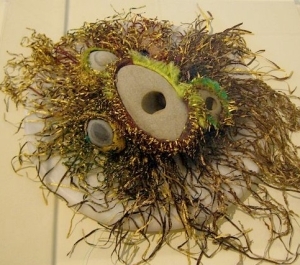 (HOST) Summer is a good time to visit your local museum or gallery, so
(HOST) Summer is a good time to visit your local museum or gallery, so
commentator and art writer Annie Guyon is here with another of her
occasional dispatches on Vermont’s visual arts.
(GUYON) Picture
this: A long, narrow subterranean room with 8-foot high, 4-inch wide
strips of vivid color delicately floating vertically in mid-air, their
ends lightly brushing a sandy floor and light glinting off furled edges.
Limpet shells, smooth stones, fossils, beach rope and a rich palette of
seaside hues glimmer everywhere – bronze, teal, amber, shimmering
silvers and swaths of gold.
Surrounded by aquatic textures and
tones, and the kelp-like forms suspended seemingly weightlessly as if in
water, I felt as if I’d walked into a giant aquarium – or the ocean
itself.
In fact, I was in an exhibit space at the Bennington
Museum, where the luminous work of textile artist Michèle Ratté is
currently on display until August 7th, in a show entitled ‘Splendent
Earth’.
And that gold I mentioned? It’s the real deal.
Ratté,
who grew up in Brattleboro before becoming a fabric designer for
Madison Avenue retailers, is the co-inventor of an innovative
photographic printmaking process in which gold and other precious metals
are affixed to cloth.
For the pieces in this exhibit, she
printed patterns of everything from lace to geometric shapes onto
hand-woven Japanese silk, sewed it into imaginative forms and
incorporated various natural objects.
In this sculptural
context, the silk can seem at once earthbound and ethereal, fragile and
indestructible, modern and antique. Whether scrunched into showy
Victoriana blooms around a tiny shell, pressed flat and adorned with
coin-size metallic spirals or hung like giant ribbons from unseen
fishing line, Ratté’s innovations are crafted with an archeologist’s
investigative eye and a jeweler’s intuitive hand.
Some pieces also incorporate her singular method of encasing stones in silk, precisely conforming it to fit like a glove.
 In
In
a piece called "Return", grey stones are wrapped tightly in gold and
orange silk as if painted but they’ve been carefully sewn into perfectly
fitted packages. Perched along spindly strands of glass and metal
beads, and adorned by clusters of tiny Cambodian bells made from spent
bomb casings, the result is a stunning alchemy of past and present,
organic evolution and human manipulation, fragility and mass.
In
"Lithoptera", stones wrapped in blue, green and gold silk are set in a
shaggy nest of metallic fishing line, like an other-worldly sea anemone.
The tallest piece in the show, "Apotrope", is a snakelike totem
of deep 23-carat gold that’s been embedded with palm-sized stones
arranged as a slim, geologic ladder, like a tendril of silk leading the
eye upward, like smoke does, and our instinct to look up when below the
surface of water.
This pairing of thin, lightweight silk with
dense, heavy rock infuses all of Ratté’s work with a compelling tactile
rhythm and grace.